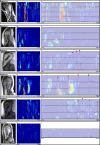Simultaneous assessment of colon motility in children with functional constipation by cine-MRI and colonic manometry: a feasibility study
- PMID: 33565002
- PMCID: PMC7873179
- DOI: 10.1186/s41747-021-00205-5
Simultaneous assessment of colon motility in children with functional constipation by cine-MRI and colonic manometry: a feasibility study
Abstract
Background: Colonic manometry is the current reference standard for assessing colonic neuromuscular function in children with intractable functional constipation (FC). Recently, cine magnetic resonance imaging (cine-MRI) has been proposed as a non-invasive alternative. We compared colonic motility patterns on cine-MRI with those obtained by manometry in children, by stimulating high-amplitude propagating contractions (HAPCs) with bisacodyl under manometric control while simultaneously acquiring cine-MRI.
Methods: After Institutional Review Board approval, adolescents with FC scheduled to undergo colonic manometry were included. A water-perfused 8-lumen catheter was used for colonic manometry recordings. After an intraluminal bisacodyl infusion, cine-MRI sequences of the descending colon were acquired for about 30 min simultaneously with colonic manometry. Manometry recordings were analysed for HAPCs. MRI images were processed with spatiotemporal motility MRI techniques. The anonymised motility results of both techniques were visually compared for the identification of HAPCs in the descending colon.
Results: Data regarding six patients (three males) were analysed (median age 14 years, range 12-17). After bisacodyl infusion, three patients showed a total of eleven HAPCs with colonic manometry. Corresponding cine-MRI recorded high colonic activity during two of these HAPCs, minimal activity during seven HAPCs, while two HAPCs were not recorded. In two of three patients with absent HAPCs on manometry, colonic activity was recorded with cine-MRI.
Conclusions: Simultaneous acquisition of colonic cine-MRI and manometry in children with FC is feasible. Their motility results did not completely overlap in the identification of HAPCs. Research is needed to unravel the role of cine-MRI in this setting.
Keywords: Child; Colon; Constipation; Magnetic resonance imaging (cine); Manometry.
Conflict of interest statement
Jaap Stoker is research consultant for Robarts Clinical Trials and has a research agreement with Takeda.
Figures


Similar articles
-
Characterization of the colonic response to bisacodyl in children with treatment-refractory constipation.Neurogastroenterol Motil. 2020 Aug;32(8):e13851. doi: 10.1111/nmo.13851. Epub 2020 Apr 13. Neurogastroenterol Motil. 2020. PMID: 32281199
-
Sequential incremental doses of bisacodyl increase the diagnostic accuracy of colonic manometry.Neurogastroenterol Motil. 2016 Nov;28(11):1747-1755. doi: 10.1111/nmo.12876. Epub 2016 Jun 23. Neurogastroenterol Motil. 2016. PMID: 27335210
-
Clinical utility of colonic low-amplitude propagating contractions in children with functional constipation.Neurogastroenterol Motil. 2023 May;35(5):e14543. doi: 10.1111/nmo.14543. Epub 2023 Feb 27. Neurogastroenterol Motil. 2023. PMID: 37096634
-
High resolution colonic manometry--what have we learnt?--A review of the literature 2012.Curr Gastroenterol Rep. 2013 Jun;15(6):328. doi: 10.1007/s11894-013-0328-2. Curr Gastroenterol Rep. 2013. PMID: 23709203 Review.
-
Paediatric and adult colonic manometry: a tool to help unravel the pathophysiology of constipation.World J Gastroenterol. 2010 Nov 7;16(41):5162-72. doi: 10.3748/wjg.v16.i41.5162. World J Gastroenterol. 2010. PMID: 21049550 Free PMC article. Review.
Cited by
-
Magnetic Resonance Imaging of the Gastrointestinal Tract: Current Role, Recent Advancements and Future Prospectives.Diagnostics (Basel). 2023 Jul 19;13(14):2410. doi: 10.3390/diagnostics13142410. Diagnostics (Basel). 2023. PMID: 37510154 Free PMC article. Review.
-
Organizing and Developing a GI Motility Lab in Community Practice: Challenges and Rewards.Curr Gastroenterol Rep. 2022 Jun;24(6):73-87. doi: 10.1007/s11894-022-00838-5. Curr Gastroenterol Rep. 2022. PMID: 35674875 Review.
-
Functional constipation in children: What physicians should know.World J Gastroenterol. 2023 Feb 28;29(8):1261-1288. doi: 10.3748/wjg.v29.i8.1261. World J Gastroenterol. 2023. PMID: 36925458 Free PMC article. Review.
-
Technical Feasibility of Quantitative Measurement of Various Degrees of Small Bowel Motility Using Cine Magnetic Resonance Imaging.Korean J Radiol. 2023 Nov;24(11):1093-1101. doi: 10.3348/kjr.2023.0144. Epub 2023 Sep 14. Korean J Radiol. 2023. PMID: 37724587 Free PMC article.
References
-
- Koppen IJN, Vriesman MH, Saps M et al (2018) Prevalence of functional defecation disorders in children: a systematic review and meta-analysis. J Pediatr 198:121-130.e6. 10.1016/j.jpeds.2018.02.029 - PubMed
-
- Hyams JS, Di Lorenzo C, Saps M et al (2016) Childhood functional gastrointestinal disorders: Child/adolescent. Gastroenterology 150:1456-1468e2. 10.1053/j.gastro.2016.02.015
-
- Benninga MA, Faure C, Hyman PE, St James Roberts I, Schechter NL, Nurko S (2016) Childhood functional gastrointestinal disorders: Neonate/toddler. Gastroenterology 150:1443-1455e2. 10.1053/j.gastro.2016.02.016 - PubMed
-
- Tabbers MM, Dilorenzo C, Berger MY et al (2014) Evaluation and treatment of functional constipation in infants and children: Evidence-based recommendations from ESPGHAN and NASPGHAN. J Pediatr Gastroenterol Nutr 58:258–274. 10.1097/MPG.0000000000000266 - PubMed
-
- Rodriguez L, Sood M, Di Lorenzo C, Saps M (2017) An ANMS-NASPGHAN consensus document on anorectal and colonic manometry in children. Neurogastroenterol Motil 29:e12944. 10.1111/nmo.12944 - PubMed
MeSH terms
LinkOut - more resources
Full Text Sources
Other Literature Sources
